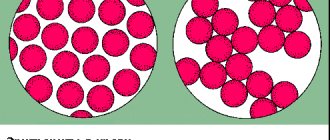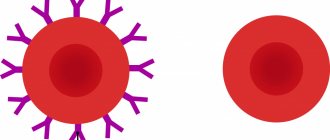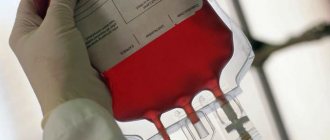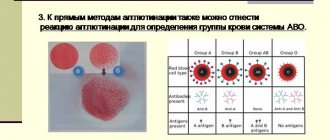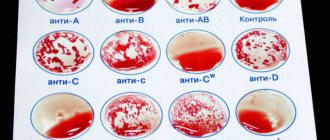Why is it important to know your blood type?
Determining blood group compatibility is necessary, first of all, for transfusion (blood transfusion). Large blood loss is deadly. Since ancient times, attempts have been made to compensate for blood loss by infusing the blood of another person. But the first blood you come across cannot be used. When mixing blood “blindly,” in about half of the cases, agglutination occurs: red blood cells (erythrocytes) begin to stick together, forming clumps. The flakes resulting from agglutination are visible in a test tube with the naked eye; it is clear that if this process happens inside the circulatory system, nothing good can be expected for a person.
Agglutination
At the beginning of the 20th century, it was established why agglutination occurs. On the surface of the erythrocyte (red blood cell) membrane there are special antigen proteins (they are called agglutinogens). They are called antigens because they can bind to other substances - antibodies. This connection is specific, that is, a given antigen can only be bound by a specific antibody. When we talk about blood groups, we use a system that is only interested in two antigens (in fact, there are many more of them “riding” on red blood cells). For convenience, these antigens (agglutinogens) are designated by the first letters of the Latin alphabet - A and B. The corresponding antibodies (they are called agglutinins) are designated by the first letters of the Greek alphabet - α (alpha) and β (beta).
Obviously, an antigen and its corresponding antibody cannot be present in the blood at the same time, otherwise a reaction (agglutination) would occur. But other combinations are possible. They are the ones who determine which group our blood belongs to.
Question 3:
What dose of anti-Rhesus immunoglobulin and in what time frame is administered to a woman with Rh-negative blood after childbirth? Is it true that the administered dose of the drug should be increased after a caesarean section?
Answer
: Women with Rh-negative blood after childbirth are given anti-Rhesus immunoglobulin in an amount of 1-1.5 ml (200-300 µg) no later than 24-48 hours after birth for prophylactic purposes. During surgical interventions, transplacental bleeding may increase, and therefore the administered dose of anti-Rhesus immunoglobulin is increased by 1.5 times.
Blood groups and their compatibility
In domestic medicine, groups are designated by a number and called accordingly: first, second, third, fourth. Abroad, this system is called AB0 and the corresponding designations are used.
Group I
(group 0) – first (or zero). People with blood of this group do not have both agglutinogens (A and B) on the erythrocyte membrane, but agglutinins α and β are present in the plasma.
Group II
(A) – second group. The blood of this group contains agglutinogen A and agglutinin β.
Group III
(B) – third group. In the blood, agglutinogen B is present on erythrocytes, and agglutinin α is present in the plasma.
Group IV
(AB) – fourth group. Both antigens are present on red blood cells, but there are no antibodies in plasma.
Whole blood can be transfused only when the blood of both the donor and recipient belongs to the same group. Red blood cells can also be used for transfusion (they are separated from the plasma), in which case only agglutinogens are important. Red blood cells of a person of the first blood group can be transfused to everyone, since they cannot introduce antigen and provoke agglutination. Therefore, a person with the first blood group is a universal donor.
Red blood cells of the second group can be transfused to people who already have agglutinogen A in their blood - that is, with the second and fourth groups. Accordingly, red blood cells of the third group can be transfused to those who have agglutinogen B in their blood; these are the third and fourth groups.
A person with blood type IV is a universal recipient: he can receive red blood cells from people with any blood type, while his blood can only be used for transfusion to people with the same blood type.
Transfusion rules
Blood transfusion requires compliance with the following rules:
- 1The blood type of the donor and recipient must match.
- 2Mandatory match for Rh factor.
- 3It is necessary to conduct compatibility tests on an individual basis.
- 4It is necessary to conduct a biological sample.
If these rules are not followed, the procedure may result in patient shock or even death.
Before transfusion, the donor's blood is checked and individual compatibility tests are performed.
When is blood type determination performed?
Indications for determining blood group are:
- the need for blood transfusion;
- preparation for operations. Any operation is a risk; under certain circumstances, it may be necessary to replace blood loss, and then doctors should know what kind of blood can be used for this;
- management of pregnancy. In some cases, there may be incompatibility between the blood groups of mother and child. If there is a blood type conflict, the child may be born with hemolytic disease of the newborn (hemolytic jaundice). To determine the baby's blood type, umbilical cord blood is taken for analysis immediately after birth. But a conflict based on blood type can also be judged during pregnancy – by the level of antibodies in the mother’s blood. The risk of blood type incompatibility between mother and child is calculated based on the likely blood type of the child, which, in turn, depends on what blood type the mother and father have. To assess this risk, it is necessary to take a test to determine your blood type during pregnancy.
Blood group determination
When doctors need to find out the blood type, the analysis is usually done again. This is done to completely eliminate the possibility of errors resulting from the use of incorrect data. The doctor will not ask the patient’s blood type, since he is responsible for his life and must have one hundred percent confidence that the blood type is determined correctly.
But knowing your blood type (and the blood type of your children) is still useful. Firstly, no one can be immune from emergencies. And secondly, there is a certain relationship between blood type and predisposition to various diseases.
Carrying out a test
Before transfusion, a compatibility check must be carried out. About 5 milliliters of blood is taken from the intended donor, placed in the machine and special serum (one drop) is added. Then a few drops of the recipient’s blood and a drop of sodium chloride solution are dropped into it. After this, observation is carried out. If the adhesion of red blood cells has not begun, it means that the donor and recipient are compatible, and the transfusion can begin.
Another way to check for compatibility is to inject the patient with several milliliters of donor blood. After this, he is observed for three minutes. If nothing happens during this time, another small amount is injected. Only after making sure of compatibility, doctors begin the transfusion procedure. To minimize the possibility of complications, the recipient is transfused with only the necessary cells, not whole blood.
Decoding the results
5 minutes pass and the analysis results can be assessed. In large drops of serum, clearing occurs, in some small flakes are formed (agglutination reaction), in others they are not. Here are the possible options:
- if there is no agglutination in both samples with sera of groups III and II (+ control 1 and 1V) - this is the first group;
- if coagulation is noted in all except II, this indicates the second group;
- in the absence of agglutination only with III serum, the third blood group is established;
- if coagulation is observed in all samples, including the 1V-control - group four.
When the sera are arranged in the correct order, with signatures on the plate, it is easy to navigate: where there is no agglutination, there is a group.
There are times when the bonding is not clearly visible. Then the analysis is redone, fine agglutination is examined under a microscope.
Rhesus affiliation
Rhesus is another antigen found on red blood cells. If it is present, the blood is defined as Rh-positive; if the protein is absent, it is said to be Rh-negative. The majority of the population has a positive Rh factor; according to the latest information, the number of this part of people reaches 85%, the remaining 15% are Rh negative.
The indicator plays a critical role in the development of hemolytic disease of newborns. Pathology is the main cause of the formation of jaundice in the fetus. Due to Rh conflict, the child may begin to disintegrate his red blood cells, since his blood components are perceived as foreign to the woman’s body, resulting in the production of antibodies.
To determine the group and Rh factor, it is necessary to take a sample for analysis on an empty stomach. Despite the fact that food intake does not affect them, as in many other laboratory studies, the material is collected in the morning on an empty stomach.
Tips for home determination
Similar advice is given by people who “live” on the Internet and collect any information indiscriminately. Sometimes they reinterpret it in their own way.
Indeed, there is a theory of nutrition depending on blood type and attempts have been made to connect personality with it. But this was developed to select the most suitable diet and prevent diseases. Even psychologists have stopped talking about the connection between personality type and blood number.
Moreover, you cannot judge your group by your favorite dishes or inclination towards leadership.
It is better to learn anything at home from full-fledged articles and consultations with specialists. There may be medical documents (outpatient records, hospital records) that contain information about your blood.
At the request of donors and hospital patients, the passport can be stamped with this information.
Similar stripes are used on army uniforms.
Nutrition
People with a third negative blood group are, as a rule, omnivorous and unpretentious, and have a good appetite. But when there is a large choice, they give preference to meat products, smoked meats, overly spicy and salty dishes, which leads to intestinal problems.
Dietary recommendations to maintain their health include moderate consumption of meat - lamb, poultry, preference for protein foods from fish and seafood. Any cereals, low-fat dairy products and cheeses, nuts, legumes, and almost all vegetables and fruits are recommended. Black tea and coffee are recommended to be consumed in moderation.
The following products are not recommended for consumption:
- fatty meat of pork, chicken, duck;
- smoked meat and fish products;
- crustacean dishes, shrimp;
- baked goods, ice cream, cakes;
- tomatoes and ketchup;
- alcohol;
- from herbs and infusions - aloe, hops, linden.
Herbal teas and drinks made from rosehip, mint and lemon balm, ginger, sage will be very useful, that is, they have a calming effect on the nervous system and improve digestion.

